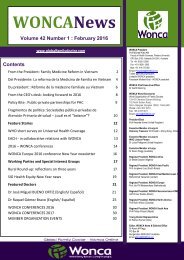You also want an ePaper? Increase the reach of your titles
YUMPU automatically turns print PDFs into web optimized ePapers that Google loves.
CONTRACEPTIONGive emergency contraception if patient had unprotected sex in past 5 days and does not want pregnancy:• First exclude pregnancy. If pregnant do not give emergency contraception 93.• Give ideally within 24 hours of unprotected sex: levonorgestrel 0.75mg 2 tablets once or norgestrel/ethinyl oestradiol 0.5/0.05mg 2 tablets and repeat after 12 hours. Offer tostart injectable/oral contraceptive at same visit.• If patient chooses, insert emergency CuT 380A intrauterine device instead.Help patient to choose contraception method• Recommend dual contraception: one method below plus condoms to protect from STIs and HIV.• In the menopausal patient: if < 50 years, give contraception for 2 years after last period; if ≥ 50 years, for 1 year after last period 98.Intrauterine device (IUCD)Subdermal implantInjectable contraceptiveOral contraceptiveSterilisationMethod Help patient to choose method Instructions for use Side effectsIntrauterine device (IUCD)• CuT 380ASubdermal implant (if available)• Etonorgestrel (one-rod: 3 years)• Levonorgestrel (two-rods: 5 years)Progesterone injection• Medroxyprogesterone acetate IM150mg 12 weekly or• Norethisterone enanthate IM200mg 8 weeklyCombined progesterone/oestrogen pill• Monophasic: levonorgestrel/ethinyl oestradiol 0.15/0.03mg• Triphasic: levonorgestrel/ethinyloestradiol (varying doses)Progesterone only pill• Levonorgestrel 0.03mgSterilisation• Woman: tubal ligation• Man: vasectomy• Effective for 10 years• Fertility returns on removal.• Avoid if patient has multiple partners, hadan STI in past 3 months or heavy periods• Lasts for 3–5 years depending on implanttype.• Fertility returns without delay afterremoval.• Avoid if current or past breast cancer or ifon certain medications 1 .• 8 or 12 weekly injection• Fertility returns 4–6 months after lastinjection.• Avoid if current or past breast cancer• If motivated to take pill daily at the sametime.• Fertility returns once pill is stopped.• Avoid if unlikely to take pill reliably, oncertain medications 1 , current or previousbreast cancer, heart or liver disease.• Choose progesterone-only pill if patient isbreast feeding, smoker > 35 years, BP ≥140/90, has migraine with focal symptomsor DVT or pulmonary embolus.• Permanent contraception• Surgical procedure• Insert within first 12 days of cycle. If later, exclude pregnancy first.• Must be inserted/removed by trained staff.• Avoid if abnormal cervix/uterus.• Small plastic rod placed just under skin of upper arm.• Must be inserted/removed by trained staff.• Use condoms for 7 days after insertion.• Choose one-rod implant for 3 years in women ≥ 80kg (if unavailablereplace two-rod implant sooner after 4 years instead of 5 years).• Can start any time in menstrual cycle: if after day 5 of cycle, need touse condoms for 7 days• No need to adjust dosing interval for HIV, TB or epilepsy treatment.• Remind patient to use condoms to prevent HIV and STIs.• Must be taken every day at the same time.• Use condoms for 7 days if started after day 5 of cycle.• Advise patient with diarrhoea/vomiting or on antibiotics to usecondoms during illness and for 7 days thereafter.• Take same time every day (no more than 3 hours late).• Start any time in cycle, use condoms for next 7 days.• If breastfeeding, start 6 weeks postpartum• Refer for assessment• Written informed consent required• Periods may be heavier, longer or more painful. Refer if excessive bleeding occursafter insertion, or if tired and Hb < 10.• Wound pain, bleeding, swelling or discharge: refer.• Irregular bleeding or amenorrhoea: reassure this is common.• Mild headaches, nausea, dizziness, breast tenderness: reassure that these shouldresolve.• Moodiness: reassure that this should resolve.• Abdominal pain – refer if pain severe or persists.• Amenorrhoea: reassure that this is common.• Abnormal vaginal bleeding: common in first 3 months 29 to assess and manage.• Severe headaches and blurred vision: switch to non-hormonal method.• Weight gain• Acne: switch to non-hormonal method.• Nausea, dizziness: reassure that this will resolve.• Tender breasts: exclude pregnancy, then reassure.• Moodiness: reassure that this should resolve. If patient has low mood or not copingas well as before screen for depression/anxiety• Amenorrhoea: exclude pregnancy then reassure.• Slight weight gain• Abnormal bleeding: common in first 3 months83 and change method.29 to assess and manage.• Severe headaches: switch to non-hormonal method and 9.• Abnormal bleeding: common in first 3 months 29 to assess and manage.• Mild headaches, nausea, breast tenderness: reassure that these should resolve.• Wound pain, swelling or bleeding: refer.1Phenytoin, carbamazepine, rifampicin, lopinavir/ritonavir may reduce the efficiency of contraceptive.91



